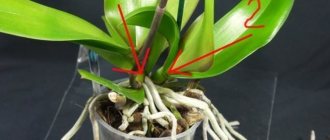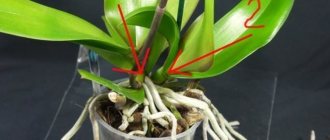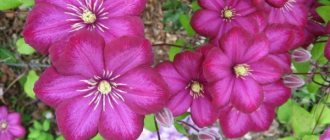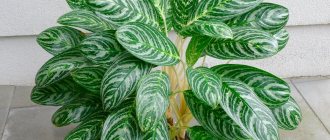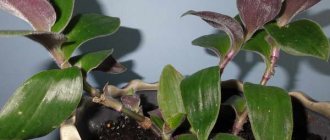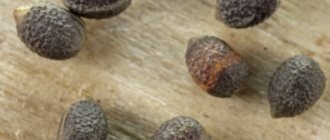Dieffenbachia is a common houseplant. It can be found in almost every home. Dieffenbachia is used very well in landscaping offices and interiors. Since this is an unpretentious plant. Its main feature is to maintain growing conditions. Considering the peculiarity of its growth in its homeland. This is a tropical plant that requires moisture, watering and lighting. Like all any indoor plants, they need fertilizing with organic fertilizers. Sooner or later the question arises: how to propagate Dieffenbachia at home.
Dieffenbachia reproduction and care. How to care
This plant belongs to the aroid family. The plant itself, in its homeland in Asia and America, reaches impressive sizes. Among indoor floriculture, this plant is valued for its decorative qualities. The plant itself consists of a powerful stem and many leaves. They come in different sizes and colors. It all depends on the variety and type of Dieffenbachia. You can read about the types of Dieffenbachia here.
This plant prefers enough light, which should be bright and diffused. Direct sunlight can damage the plant, leaving it with sunburn. If there is not enough light, the color of the leaves may change. Decorative qualities are lost. You can use additional lamps or phytolamps.
The plant has no particular requirements for soil. Or rather, ordinary soils for indoor plants are suitable. You can add some peat and sand to them. Or choose a similar soil that contains peat.
Watering must be well organized, it must be abundant and timely. We do not allow the earthen clod to dry out, and excess moisture should be removed from the pan. Over-wetting the soil can lead to the death of the plant or infection with fungal diseases.
Reproduction of this decorative foliage step by step
There are many reasons for propagating a flowerpot:
- it may need updating, since the old Dieffenbachia will eventually not only rest against the ceiling and begin to grow parallel to it, but will also begin to resemble a bare stick topped with a bunch of leaves;
- your flowerpot may be broken;
- From one Dieffenbachia you will need to make several for friends or for sale.
Below I will talk about the most popular household methods of propagating Dieffenbachia. I won’t talk about the seed method.
Firstly, we practically cannot get seeds, and secondly, this method is too time-consuming and unreliable. Only breeders growing new varieties turn to him.
Rare species of bush Dieffenbachia can also be propagated by dividing the bush. This is done during transplantation.
Remember! Dieffenbachia is known for its poisonous sap. Therefore, it is better to carry out all manipulations with it with gloves!
Apical cuttings
This is the easiest way - as well as the fastest, because the growth point of such plants is precisely at the top. Having taken root in this way, Dieffenbachia will grow a leaf every week, very quickly turning from a cutting into an adult plant.
- Cut the top so that the cutting is 10 to 15 cm in size. There is no need to cut it longer - even if a large cutting sends out roots, it will be difficult for them to “feed” such a plant by extracting useful substances in the soil.
- Milky juice will begin to ooze from the cut. It needs to be removed. Some people wash the cuttings under the tap, others rinse the cut in a glass of water (changing the water as needed), and others simply wipe it with a few paper napkins. All options are correct.
- You can root the cuttings in a glass of clean water (or mixed with energy drink - succinic acid, Epin), a wet mixture of peat and sand, or moss. There is no need to deepen the cutting very much - 2-3 centimeters will be enough. Before rooting, the cut can be dipped in Kornevin - this product accelerates the appearance of roots.
- Keep the cutting in a warm place (22-24 degrees), keep it away from direct sunlight, and spray frequently.
- If the cutting is standing in water, you will not miss the appearance of roots. Allow them to grow to 3 cm, and you can plant the plant in a personal pot.
- Are you growing Dieffenbachia in the ground? The signal about the appearance of roots will be new leaves that grow on top of the plant. If you see such leaves, you can replant the cuttings into more serious soil.
By the way! After cutting off the top, do not throw away the stump if it (and the roots) are healthy. Leave it at least 10 cm long.
Blot the stump from any oozing juice, and then seal it with wax from a burning candle (it will protect it from rot - although this is not a necessary condition). Water the plant, and after some time new tops (one, or even several) may sprout on the sides of the “seal”.
Dieffenbachia can be left as is. But if you think that the “hemp” plant looks untidy, you can cut off all the grown tops and root it.
Stem cuttings
The bare trunk of Dieffenbachia will also work.
It can be dried (washed) of juice and used in two ways.
- Cut the trunk into cuttings of about 10 cm. The main thing is that each has at least one internode. Dip them on the bottom side in Kornevin (optional), and seal the top side with wax. Stick the lower part into water, wet moss, sand, sand + peat. Root them as described above.
- Place the cuttings sideways in the ground (as in the photo above). If you see buds, make sure they are on top. Cover the pot with film (transparent bag) and keep warm. In this case you need about 25 degrees. The rooting of these shoots will be indicated by the sprouts that appear on the cuttings. They can grow in a row on this cutting.
Lateral processes
Most Dieffenbachias only grow upwards. But some species also have lateral buds. I show you what they look like in the photo above.
From here, over time, a shoot will appear. When it gets stronger, you can cut it and root it like a cutting.
Air layering
An option for those who are interested. It will also help out if you need to propagate a plant, but it is still too young - there is nowhere to cut the cuttings from.
Everything is done like this:
- Make a cut in the “bark” in a circle on the trunk.
- Cover the bare “wood” with moistened sphagnum moss and wrap it with transparent film on top. If it does not hold, fix it with tape, tape, etc.
- Did you see the roots? You can cut off the top part of the stem with these roots and plant it in a pot. Don't pick moss.
- Dry the lower part of the plant; you can seal it with wax.
By the way, ficus trees can be propagated in the same way.
Dieffenbachia propagation options.
This plant is good because it can be propagated in various ways, which we will consider: (propagation of Dieffenbachia by cuttings, propagation of Dieffenbachia by leaves, how to prune Dieffenbachia for propagation). You can choose any one. Reproduction is usually associated with plant renewal. It can be renewed during transplantation or when its decorative qualities have deteriorated. Deterioration in decorative qualities may be caused by depletion of nutrient soil, which can be replaced during replanting.
Changes in temperature conditions and drafts can also lead to loss of decorativeness. Despite all the possible problems, Dieffenbachia can and should be propagated. Thus updating the main plant, and breeding new young specimens. This is especially true if you notice a new variety among friends and want the exact same plant for yourself. Under natural conditions, Dieffenbachia can reproduce by pollination and through seeds. Unfortunately, at home, propagation through seeds is quite problematic and it is not always possible to obtain the desired result. The plant needs to be pollinated, then the seeds should be allowed to ripen, then dried and stored. Then they are planted and germinated.
You can root the Dieffenbachia stem in water and soil.
We will consider the most reliable and proven methods of reproduction below:
Necessary conditions for plant propagation
Dieffenbachia is an indoor flower, for its propagation it is necessary to create certain conditions in the house. First, you should choose the right time for this procedure. Typically propagation is carried out in spring or early summer. It is worth noting that cuttings prepared in winter do not take root for quite a long time. Moreover, it is not possible to speed up the process even with high-quality care of the appendage.
The survival rate of the plant can be improved by choosing the right soil. This indoor flower prefers light soils. You can also use universal soil by adding peat-sand mixture or vermiculite. Before filling the pot with soil, you need to organize a drainage layer at the bottom. The container itself should be spacious, since Dieffenbachia is characterized by active growth and quite quickly fills all the space available to it in the pot. When growing this flower at home, you need to know that its juice is poisonous to animals and humans. Therefore, all manipulations with the plant should be performed with rubber gloves. After completing work, hands should be washed well with soap. Also, when interacting with this homely beauty, you need to protect not only the skin of your hands, but also your eyes along with the mucous membranes. Because of this feature, Dieffenbachia must be grown in a place inaccessible to children and animals.
Propagation by cuttings
The most proven and well-known of the reproduction methods. For propagation by cuttings, you should choose a suitable Dieffenbachia stem. It is enough to take a stem at least ten centimeters long. The ideal time for reproduction is spring. But given the unpretentiousness of the plant itself, this can be done throughout the year. Cuttings are part of the stem of the main shoot that we cut. It must be in good condition, without signs of rotting, stains, or other diseases. If you find damage, it is better to cut it off and use the healthy part of the cutting.
You can also use the simplest method for rooting cuttings. We put our cuttings in a container with water. You can take a transparent jar. This way the light will also fall on that part of the shoot that is in the water. The water should be disinfected. To do this, you can dilute activated carbon in the water where you plan to keep the cuttings. The container should be in a warm and bright place - usually a windowsill. Given the peculiarity of this cutting method, the water must be changed to avoid its attenuation and rotting of the cuttings.
Tip: try to root one cutting at a time. It is not advisable to place several cuttings in a container with water; in close contact, the cuttings may begin to rot. You can use stimulating solutions and preparations for better rooting of cuttings.
After some time, roots begin to form on the cuttings. Don't rush to plant them, let them grow. It is enough to maintain their length of about five centimeters. Next, prepare containers for planting. Fill them with soil and carefully plant the cuttings. The roots are very fragile, so this procedure should be carried out very carefully. It is better to fill half the pot with soil. Place or position the cutting so that the roots are in light contact with the soil. And carefully add soil to the level you need.
You can also root the cuttings directly in the soil. For this process to be more successful, the soil must be prepared. Or rather, we will take peat as the basis of the soil and add perlite or vermiculite to it. Mix everything into one common mass. Everything is taken in equal parts. You can also use sphagnum when rooting cuttings. Take half of it, and half will consist of peat and vermiculite or perlite. The peculiarity of sphagnum allows you to improve the rooting process. Sphagnum provides such qualities as soil porosity, which in turn promotes the evaporation of excess moisture. The soil turns out to be loose and crumbly, this allows young roots to germinate unhindered, and its light texture provides good oxygen saturation. We also use activated carbon, as in the case of reproduction in water. This will prevent and prevent the shoots from rotting.
- — we cut the cutting, it should be strong and healthy, without signs of damage or disease.
- - You need to let it dry, a day is enough.
- — take the root and make a solution, then keep the cutting in this solution for about five to nine hours.
- - The cuttings should be planted in a prepared container, to a depth of no more than five centimeters.
- — we create a greenhouse effect, for this we use a bag or film.
Advice: the greenhouse effect is only good if you take cuttings in winter, since you need to maintain an optimal temperature. If you are cutting in the summer, then there is no need to cover the container with a bag or film.
Features of rooting in water and soil
To root in the substrate, you need to follow several rules:
- the composition of the soil mixture should include sand, crushed charcoal and sphagnum in a ratio of 3:2:1;
- Watering the planting material should be done with water with “Fitosporin” and root former diluted in it (each of the preparations is added to 1 liter of warm water on the tip of a teaspoon);
- moisten the soil moderately to prevent rotting of the trunk;
- Spray the seedling once a day.
Attention! Rooting in water occurs by placing planting material in a container with liquid.
The following recommendations must be observed:
- dissolve 1–2 tablets of crushed activated carbon in clean water;
- place the jar with the seedling in a warm place with a temperature of +20 to 24 °C, excluding direct exposure to ultraviolet rays;
- change the water regularly (1-2 times a week);
- When the root system reaches 2–3 cm, plant the young plant in the ground.
Propagation by apical stem
The only difference between the cutting and the apical stem is that the apical stem has leaves and an unformed shoot. This is usually the younger part of the plant. The main feature of this method is to obtain the most ornamental plant. Which already has leaves and part of the stem with a root system. This plant looks more decorative.
This cutting method can be used. If you need to improve the appearance and decorative qualities of your adult plant. Dieffenbachia tends to expose the trunk with age. This method is also good for plant diseases, especially when the root system rots. When the main plant is already on the verge of death, but the upper part is still healthy and can be used for propagation.
- - cut off the top shoot of the main plant. Select a cutting level just below the young shoot.
- — put our stem in water for a while, with activated carbon diluted in it.
- — it is necessary to create comfortable conditions, the temperature should be approximately 20-22 degrees.
- — We change the water in the container weekly, this will avoid rotting of the cuttings.
- - as soon as the roots grow (this is 3-5 centimeters), plant them in a prepared container with soil. The composition of the soil is the same as with the first cutting method.
In the cold season, be sure to cover it with a bag to create a greenhouse effect. But the package must be opened periodically for ventilation purposes.
Caring for seedlings
Transplanting seedlings is a labor-intensive and painstaking process. In general, Dieffenbachia does not like transplantation. And small seedlings can be easily damaged during this process
Therefore, they are carefully dug up along with a lump of earth and transferred to an individual pot.
After transplantation, the seedlings are watered moderately and placed in partial shade. They need this lighting for 2 weeks. They can then be gradually accustomed to brighter lighting.
Sometimes, even with careful transplantation, the root system of the seedling is still disturbed. At the same time, its leaves droop and lose their elasticity.
If the damage is not fatal, the young plant can be saved. To do this, it is covered with a glass jar to create a consistently humid atmosphere. Usually, under such conditions, the seedling recovers within 6-7 days.
As seedlings grow, they need regular spraying. This is done 2-3 times a week. It is advisable to use a finely dispersed water spray so that only the air near the plant is humidified, but the water does not fall on the leaves and shoots.
Propagated by the main stem
We use this method of propagation when rejuvenating the mother plant. In order to understand whether the plant needs to be rejuvenated or not. There are a number of signs: your plant has become too elongated and the trunk is well exposed as the lower leaves are gradually dying off. Also, the stems are quite old and over time they begin to become covered with a brown crust. The foliage in the middle of the plant begins to slowly turn yellow. In principle, the method repeats both the first and second methods of cutting. If your plant is not tall, you cut off the apical shoot; if the plant is elongated, cut the shoot to the required length and, if desired, cut it, dividing it into several parts. The principles are described above.
Pest and disease control
Dieffenbachia belongs to those plants that clearly and visually signal the owner about problems that have arisen.
Most often this is expressed in:
- drying of leaf tips, which may indicate insufficient air humidity, increased soil acidity or the presence of drafts;
- rapidity in the fall of the lower tier of leaves, caused by a lack of moisture in the soil or the tightness of the pot;
- pale green color, provoked by excessively bright lighting or excess phosphorus content in the soil;
- deformation and crushing of leaves, which indicates an excessive alkali content in the soil;
- root rot caused by overwatering;
- thinning of the stem, indicating the old age of the bush.
Fungicidal preparations (for example, Fitosporin-M) will help get rid of many serious problems.
In addition to violations of agricultural practices, the plant may suffer from pest invasion in the form of:
- mealybug, which forms flakes in the form of flour on the bush and soil, and which is most effectively combated with the help of the preparations “Mospilan” or “Aktara”;
- thrips, due to which dark drying spots appear on the leaves, and which are combated with insecticides by repeatedly spraying the bush every 2 days (covering the plant with a plastic bag helps);
- spider mite, which reveals its presence by drying leaves and poorly visible cobwebs on their back side (the mite is destroyed with insecticides by spraying and covering the bush with a transparent bag for several days, repeating the procedure every week);
- aphids, which provoke yellowing of the leaves (fight with garlic infusion, a solution of laundry soap and even beer).
Important! Constantly low ambient temperatures can lead to the formation of brown spots on the leaves.
Propagation by leaf
For this method of propagating Dieffenbachia, we use a leaf. It should be well developed, without visible damage or disease.
- — we determine the leaf that we will use for propagation and cut it off.
- - the sheet needs to be dried.
- - decide on the container and put the sheet in the water.
- - with the appearance of the first roots, replant into prepared soil and a pot of the required size.
You can also root a Dieffenbachia leaf directly in the soil, but this is a riskier option and does not always lead to the desired result.
Useful care tips
There are several useful recommendations that allow you to get effective results when propagating and growing Dieffenbachia:
- place a young plant in the first year of its life on windows facing east or west;
- maintain diffused lighting;
- provide the climate regime necessary for growth with an air temperature from +20 to 25 ° C, an average level of humidity, moderate watering;
- periodically turn the flower pot towards the sun, as the plant reaches for the light;
- Apply fertilizers to the soil once every 2 weeks (it is recommended to use fertilizers specially designed for Dieffenbachia);
- Moisten the foliage daily by spraying with warm water.
You can learn more about plant care from the video:
Dieffenbachia is a poisonous plant, so placing it in a children's room is not recommended, and it should not be accessible to pets, in particular rodents.
We propagate by shoots
This method is good if the main plant has developed side shoots. Which over time began to grow, preventing the main plant from developing and growing well.
- - the young shoot should be cut so that it already has several leaves. Two or three will be enough.
- - Next we carry out the rooting process in water in which coal must be dissolved.
- - wait for the roots to appear
- — we plant the young plant in a permanent place in a pot with soil. Be sure to take care of drainage.
- — there is no need to make a greenhouse from a bag, since this is a ready-made and formed plant.
Air layering
This method is not so simple, but also quite effective. An incision is made on the bare stem into which a small support (match, toothpick, etc.) is inserted. Some gardeners remove a circular strip of bark 1.5–2 cm wide.
Then the open areas need to be treated with a root growth stimulator, wrapped in moistened moss and wrapped in polyethylene. The film is secured at the top and bottom using wire or rope. After 1.5–2 months, when the roots appear, the branch is cut off and planted in the ground. The sections are pre-dried a little and sprinkled with charcoal.
We propagate during transplantation
This is the easiest way to reproduce. This method is usually used when replanting a plant. This is a good reason to divide the mother plant and separate several shoots. This procedure promotes freer development of the roots of the main plant.
- - when replanting, remove the plant. We try to preserve the earthen ball with Dieffenbachia roots.
- - to unravel the roots and understand where and how to separate them, rinse the roots with water. Or place the plant in water and carefully wash off the soil.
- - The roots should be inspected for rot and damaged roots. If any are found, we clean the roots.
- - divide the plant and dry them.
- - after a day, you can plant the plants in a ready-made pot with soil.
Dividing the roots
Important! Since Dieffenbachia does not tolerate cramped conditions, transplanting into a larger container will benefit the plant.
Reproduction by dividing roots occurs according to the following algorithm:
- remove the plant from the pot, being careful not to damage the earthen ball;
- the root system is washed with running water and inspected for dark spots and rot;
- remove damaged fragments if necessary;
- dry for 24 hours;
- The perennial is planted in the prepared substrate.
Roots can be disinfected by treating them with a weak solution of potassium permanganate or an activated carbon solution.
The main mistakes when propagating Dieffenbachia.
All the reproduction methods described above are quite simple. But if you violate a number of procedures, you can fail.
- - sterility is compromised. We make sure to disinfect all the tools you use. This is especially true for knives and pruning shears.
- — when planting and rooting shoots, the wrong pots may be selected. They can be either too big or, conversely, too small. Which can lead to problems in the development of the root system or to its decay.
- - the most common mistake that occurs during division and transplantation. This is damage to young roots. They can be damaged during planting. Pressed hard or crushed. Also, the root can be damaged when dividing the bush. Therefore, planting is carried out carefully and gently.
If you follow these simple, at first glance, methods and methods of propagating Dieffenbachia. You can get beautiful and healthy plants that will delight you for a long time. You will know how Dieffenbachia reproduces. Good luck to you.
Preparation for reproduction
For growing Dieffenbachia, clay pots of appropriate size for the development of the plant's root system are best suited. Those selected “for growth” are not suitable, this is fraught with rotting of the roots. As the flower grows, it is better to replant it again into a larger container.
Important! Experts consider modern plastic pots to be uncomfortable for Dieffenbachia, since the lack of pores in the plastic makes air exchange in the root system difficult, and
soil moisture is not regulated.
A drainage layer in the form of crushed bricks and charcoal should be placed at the bottom of the flower pot. Properly selected soil plays a special role in the process of plant propagation.
The best substrate is peat mixed with vermiculite (perlite), combined in equal proportions. High-quality soil is also obtained from sphagnum, peat soil and perlite (vermiculite), where half of the volume is sphagnum, and the rest is presented in equal shares.
In order to prevent rotting of the root system, it is recommended to enrich the prepared soil with activated carbon (in the proportion of 1 tablet per 0.5 liter of substrate).
